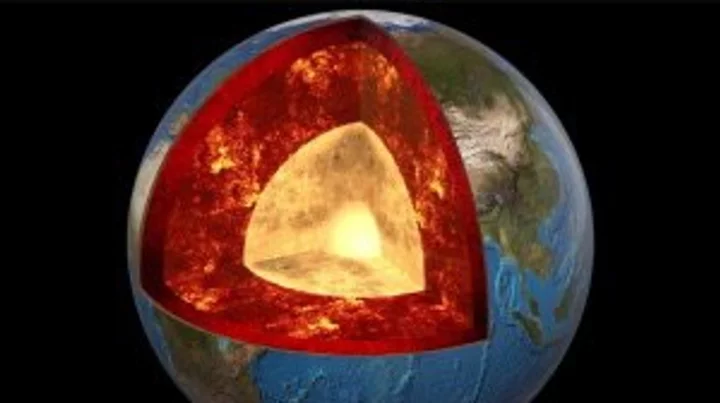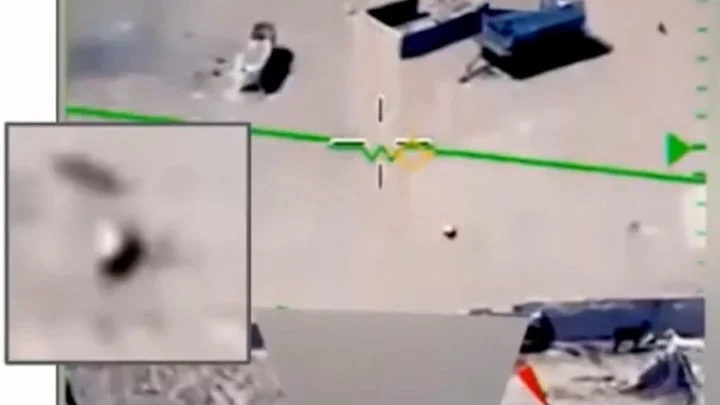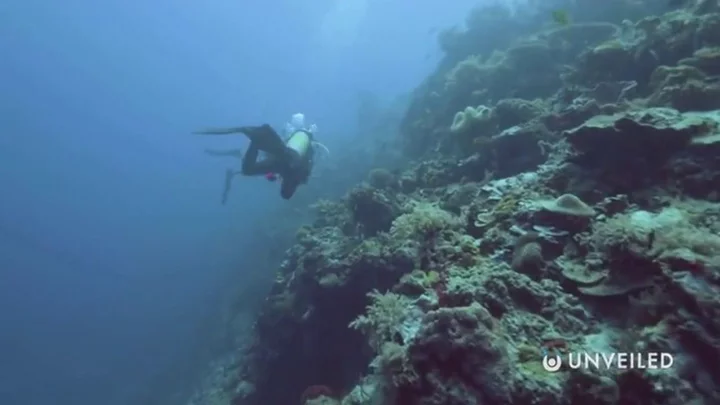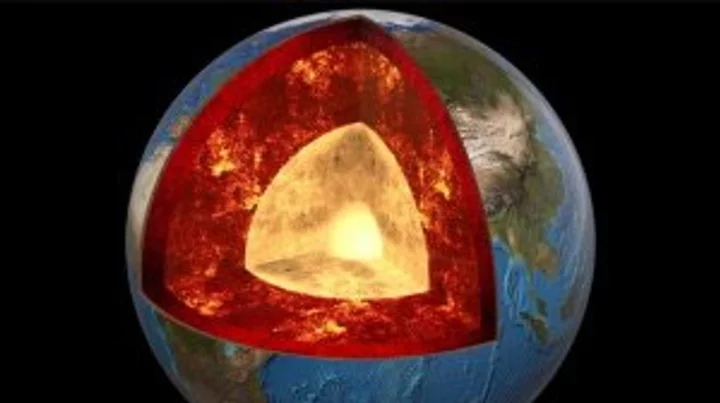
Two giant 'blobs' in Earth's core could be remains of an ancient planet
Many of us look to the stars for answers to life’s most complex questions. But actually, some of the greatest mysteries lie beneath our very feet. One might think we’d know the Earth pretty well by now but, in fact, our planet’s core remains shrouded in enigma. Indeed, there are two gigantic blobs located beneath Africa and the Pacific Ocean that occupy around six per cent of the world’s entire volume. And yet, we’re still not entirely sure what they’re made of or where they came from. There are a number of hypotheses, including that they are piles of oceanic crust that have accumulated over billions of years. Sign up for our free Indy100 weekly newsletter But a more interesting theory is that they are huge chunks of an ancient planet that hit the Earth around 4.5 billion years ago. To give an indication of just how massive these things are, the structure under Africa – an area known as Tuzo – is thought to be around 800km (497 miles) tall – the equivalent of some 90 Mount Everests stacked on top of one another, as IFLScience notes. The problem with determining the origin of these monster formations is that there are no direct ways of observing the Earth’s core. The deepest hole humans have ever dug – branded the "entrance to hell" – reached a pretty staggering 12,263m (40,230ft), but that doesn’t even come close to breaking through the crust to the layers beneath. Our most effective tool for analysing what lies beneath the ground is a technique called seismic tomography, which looks at how waves of energy travel when earthquakes occur. Since rocks and liquids have different densities, the waves move through them at different speeds. By measuring the tremors from different points on the surface, geologists can determine what kind of material the waves are travelling through and, in so doing, map out the Earth’s interior. It was by using this technique that the two unusual structures – known as large low shear velocity provinces (LLSVPs) – were found. Waves travel more slowly in these areas – fondly known as “blobs” – than through the surrounding lower mantle, indicating that they’re made of something different. We can’t tell what this material is based on seismic tomography data alone, but some scientists like to believe that they are the remnants of an ancient planet called Theia – an idea known as the “giant impact hypothesis”. According to this hypothesis, around 4.5 billion years ago, a Mars-sized object collided with the Earth. This impact not only created the planet we call home today, but also threw off enough rock to form the moon that lights up our night skies. Some scientists suggest that some of Theia’s leftovers also sunk to the bottom of the planet, probably settling somewhere above the core – thereby forming at least one of the two LLSVPs. More Updates About Strange Blob Structures Inside Planet Earth youtu.be Experts have been investigating the area for decades but there’s still no way of knowing for sure just what these two giant blobs are. Still, studies into Theia have offered important insights into how the possible collision might have kickstarted key plate tectonic and mantle motion inside our planet – crucial processes for establishing the world on which we live. It’s also a useful reminder that we still have so much to learn about our planet and where we came from. Have your say in our news democracy. Click the upvote icon at the top of the page to help raise this article through the indy100 rankings.
2023-06-14 15:17

Ken Griffin Ramps Up Credit Trades, Anticipating US Recession
Ken Griffin, whose hedge fund churned out a record $16 billion for clients last year, is increasing his
2023-06-14 11:56

India’s Frequent Internet Shutdowns Hurt Its Most Vulnerable
India’s frequent and arbitrary internet shutdowns hurt its most impoverished, who depend on government social protection programs, according
2023-06-14 10:49

Microsoft Purchase of Activision Temporarily Blocked by Judge
Microsoft Corp.’s $69 billion acquisition of Activision Blizzard Inc. was temporarily blocked by a federal judge in California,
2023-06-14 08:56

Pro-Russian hackers step up attacks against Swiss targets, authorities say
GENEVA (Reuters) -A pro-Russian hacking group had intensified its cyberattacks against Switzerland, authorities said on Tuesday, with hackers claiming to
2023-06-14 02:23

Animation goes viral for showing 'what happiness really looks like'
Happiness is one of life’s most elusive gifts – it is an emotion that can’t be pinned down. And yet, an animation showing a protein molecule “walking along”, carrying a large sphere, is widely credited with being a visual representation of joy itself. The gif has trended online for almost a decade but continues to breed delight in those who see it. Many people believe that it is – to use the technical terms – a myosin transporting endorphins in the brain. In other words, it is a scientific portrayal of the actual processes that give us that warm and fuzzy feeling. Sign up for our free Indy100 weekly newsletter However, though we’d hate to dampen the mood, this isn’t quite accurate. In fact, the real brain behind the original clip, medical artist John Liebler, set out the truth back in 2014. @mommyca713 AMAZING! #cells #innerlife #happiness #lookslike #facts #fact #fyi #fyp #brain #research #facts #animation #myosin #interesting #education #viral #fypシ #humanbrain #mentalhealth #science #stem He explained that he, his team at medical technology company XVIVO, and two Harvard University researchers created the 3D computer animation in 2006 for a biology classroom video called ‘The Inner Life of the Cell’, as Science Alert reports. The educational clip wasn't intended to depict a brain process at all but to take the viewer "on a journey through the microscopic world of a cell, illustrating mechanisms that allow a white blood cell to sense its surroundings and respond to an external stimulus,” according to Liebler himself. So this is all about a protein in a white blood cell, not a protein in a neuron. The Inner Life of the Cell Animation youtu.be At any rate, happiness doesn’t just come about through a single process. So even if the clip did show endorphins being delivered to our brains, this wouldn’t offer a full picture. Dopamine, other neurotransmitters (for example, serotonin), biological health and genetics all play a part in cementing our feelings of contentment. We don’t just rely on jolly little myosin proteins lugging around bundles of cheer. Still, the internet is now awash with jovial variations on the clip and it can’t be denied that the scene-stealing strutting protein is pretty damn cute. So if that’s enough to bring a smile to your face, maybe it is a representation of happiness after all. Have your say in our news democracy. Click the upvote icon at the top of the page to help raise this article through the indy100 rankings.
2023-06-13 18:19

China’s Top Broker Sees Earnings Relief for Hong Kong Stocks
Analysts at China International Capital Corp. are suggesting investors load up on Hong Kong stocks, wagering that the
2023-06-13 13:50

Astronomers have finally figured out the source of the brightest explosion ever recorded
Astronomers believe they might have found the source of the brightest explosion ever in space. The record-breaking explosion recorded in October 2022 was the most powerful ever seen, leaving equipment and instruments struggling to measure it as it pointed directly at planet Earth. The bright gamma-ray burst is officially called GRB 221009A and when it first went off, scientists were left scrabbling to point telescopes in its direction to record it. The explosion has affectionately been nicknamed BOAT, standing for “brightest of all time”, and was caused by the death of a large star located 2.4 billion light-years away – relatively close in terms of space activity. The star collapsed into a black hole after ejecting its outer envelope, causing this huge, bright explosion comprised of gamma rays, producing not only a narrow structured jet but with an additional outflow of gas. Sign up to our free Indy100 weekly newsletter This “exceptionally rare event” surprised astronomers, who had not predicted the existence of gas, and certainly provides plenty of new information around the question of how black holes form. The study’s lead author and astronomer from George Washington University, Brendan O'Connor, explained: “GRB 221009A represents a massive step forward in our understanding of gamma-ray bursts, and demonstrates that the most extreme explosions do not obey the standard physics assumed for garden variety gamma-ray bursts.” He continued: “GRB 221009A might be the equivalent Rosetta stone of long GRBs, forcing us to revise our standard theories of how relativistic outflows are formed in collapsing massive stars.” The huge and long-lasting blast measured up to 18 teraelectronvolts which is a staggering record for a gamma-ray burst, leaving scientists to hypothesise that it was a supernova. Have your say in our news democracy. Click the upvote icon at the top of the page to help raise this article through the indy100 rankings.
2023-06-12 22:26

War in Ukraine Prompts Increased Cyberattacks on German Businesses
More than one in 10 German companies were the victim of a cyberattack last year, according to a
2023-06-12 15:50

Massive ocean discovered beneath the Earth's crust containing more water than on the surface
It feels like there have been staggering science stories emerging every other day recently, all of which have blown our tiny little minds. First, there was the discovery of a terrifying black hole pointing right at us, then there was a huge hole found in the sun and a missing continent found after going missing for 375 years. Now, people are only just realising that there’s a massive ocean hidden under the Earth’s crust. It turns out there’s a huge supply of water 400 miles underground stored in rock known as 'ringwoodite'. Sign up to our new free Indy100 weekly newsletter Scientists previously discovered that water is stored inside mantle rock in a sponge-like state, which isn’t a liquid, solid or a gas, but instead a fourth state. The scientific paper titled ‘Dehydration melting at the top of the lower mantle’ was published in 2014 and laid out the findings. "The ringwoodite is like a sponge, soaking up water, there is something very special about the crystal structure of ringwoodite that allows it to attract hydrogen and trap water," said geophysicist Steve Jacobsen at the time. "This mineral can contain a lot of water under conditions of the deep mantle,” added Jacobsen, who was part of the team behind the discovery. He added: "I think we are finally seeing evidence for a whole-Earth water cycle, which may help explain the vast amount of liquid water on the surface of our habitable planet. Scientists have been looking for this missing deep water for decades." Scientists made the findings at the time after studying earthquakes and discovering that seismometers were picking up shockwaves under the surface of the Earth. From that, they were able to establish that the water was being held in the rock known as ringwoodite. If the rock contained just 1 per cent water, it would mean that there is three times more water under the surface of the Earth than there is in the oceans on the surface. Have your say in our news democracy. Click the upvote icon at the top of the page to help raise this article through the indy100 rankings.
2023-06-12 15:28

Ancient formation discovered wrapped around Earth's core
The structure of the Earth beneath our feet has been fascinating to members of the scientific community recently, and it turns out it’s far more complex than people initially thought. First, we learned of the news that there’s a massive ocean beneath the Earth’s crust which contains more water than all of the seas on the surface. Now, another study has been published which has taken an in-depth look at the geology beneath the southern hemisphere. The new research, published in Science Advances, has found evidence that an entire ocean floor actually runs the length around the core. Sign up to our new free Indy100 weekly newsletter This is a relatively thin layer that sits on the core-mantle boundary around 1,800 miles beneath the surface of the Earth. It's an ancient formation that could provide more insight into the structure of the planet beneath our feet. Geologist Samantha Hansen and her colleagues from the University of Alabama led the research. They observed the structure by using 15 monitoring stations under the ice of Antarctica, mapping the waves from earthquakes. Doing this allowed them to analyse the structure of the Earth below the surface, including the ultra-low velocity zones where waves moved much slower. "Seismic investigations, such as ours, provide the highest resolution imaging of the interior structure of our planet, and we are finding that this structure is vastly more complicated than once thought," Hansen said. "Analyzing [thousands] of seismic recordings from Antarctica, our high-definition imaging method found thin anomalous zones of material at the CMB everywhere we probed," geophysicist Edward Garnero from Arizona State University also said. "The material's thickness varies from a few kilometers to [tens] of kilometers. This suggests we are seeing mountains on the core, in some places up to five times taller than Mt. Everest." "Our research provides important connections between shallow and deep Earth structure and the overall processes driving our planet," Hansen added. Have your say in our news democracy. Click the upvote icon at the top of the page to help raise this article through the indy100 rankings.
2023-06-12 15:21

Microsoft Gaming Chief Doesn’t See a Need for New Xbox Yet
Microsoft Corp.’s video gaming chief Phil Spencer said he doesn’t “feel an imperative” to come out with a
2023-06-12 10:51
